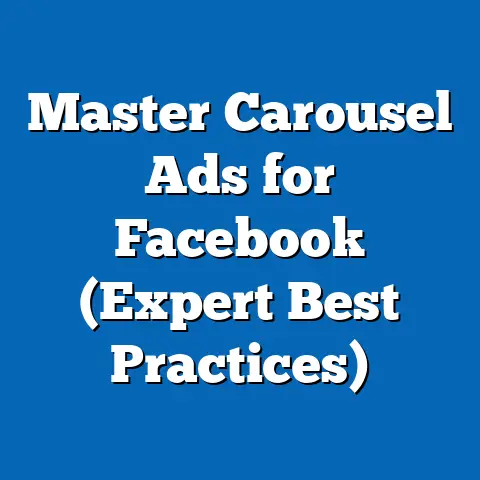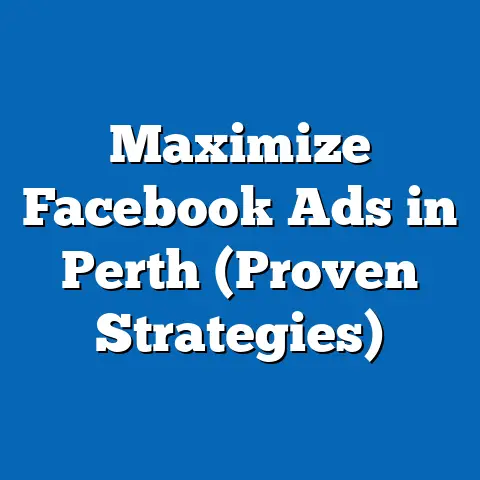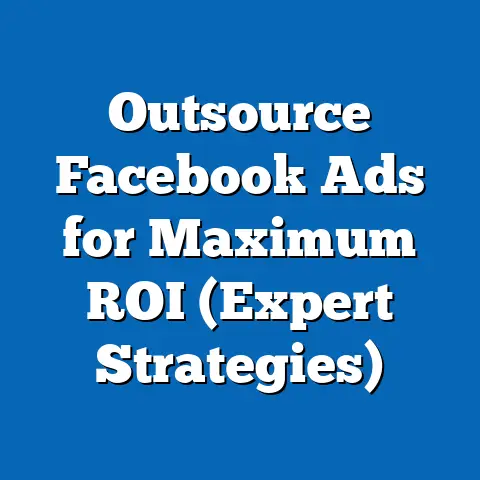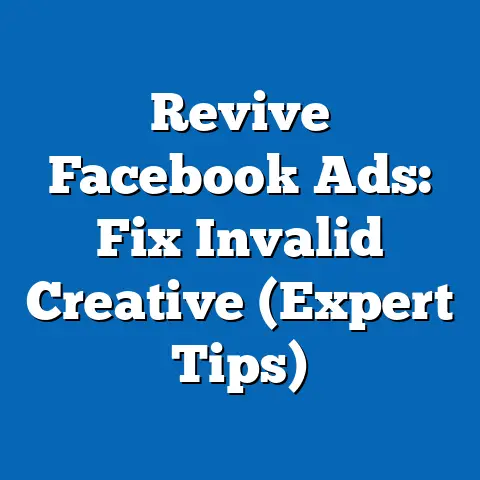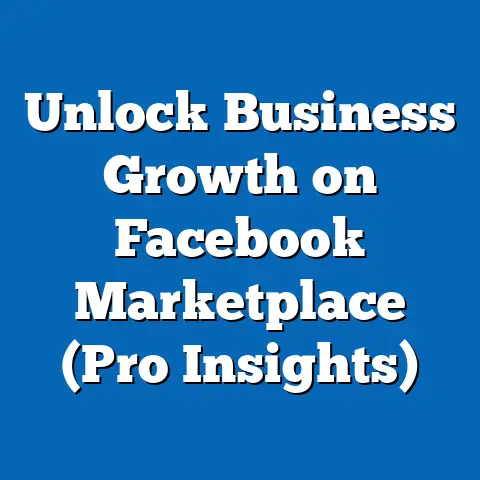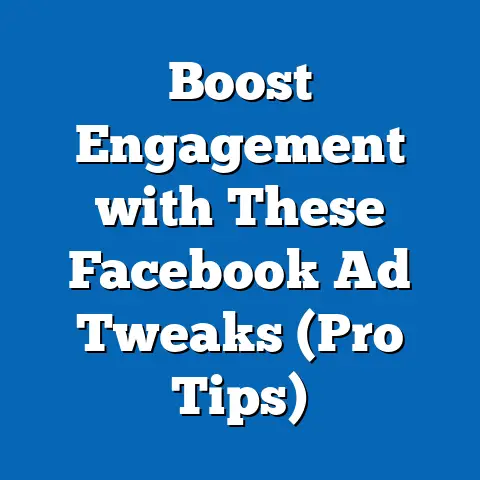Master Targeting in Facebook Ads (Proven Strategies Inside)
Mastering Targeting in Facebook Ads: Proven Strategies Inside
Have you ever walked into a beautifully renovated home and thought, “Wow, this is exactly what I wanted”? That feeling of perfection, of every detail aligning with your vision, is what we aim for in Facebook advertising. Just as a successful home renovation requires understanding the homeowner’s specific needs, desires, and lifestyle, effective Facebook advertising hinges on deeply understanding your target audience.
I remember working with a local bakery that specialized in gluten-free treats. They were struggling to reach the right customers in their area, and their Facebook ads were falling flat. It was like building a stunning kitchen without knowing if the homeowner even cooked! By meticulously defining their ideal customer – health-conscious individuals, those with gluten sensitivities, and local foodies – we were able to transform their advertising. We tailored their ad copy, visuals, and targeting to resonate with this specific group, and the results were phenomenal. Their online orders skyrocketed, and their bakery became a local hotspot for gluten-free delights.
Another time, I helped a small landscaping business revitalize their marketing efforts. They had always blasted their ads to the entire county, hoping to capture a few leads. But their messaging was generic, and their ads got lost in the noise. It was akin to renovating a house with no architectural plan! We realized that homeowners in different neighborhoods had distinct landscaping needs. By segmenting their audience based on location and home value, we created targeted campaigns that spoke directly to those needs. The result? Higher engagement rates and a significant increase in qualified leads.
These stories illustrate a crucial point: effective targeting isn’t just about reaching a large audience; it’s about reaching the right audience. It’s about understanding their needs, desires, and behaviors and crafting a message that resonates with them. In this guide, I’ll walk you through proven strategies to master targeting in Facebook Ads, helping you transform your advertising efforts and achieve remarkable results.
We’ll explore the power of Facebook’s targeting capabilities, learn how to define your ideal customer profile, craft compelling ad content, leverage advanced targeting techniques, monitor and optimize your strategies, and stay ahead of Facebook’s ever-evolving algorithms. Just as a skilled contractor uses the right tools and techniques to bring a renovation project to life, you’ll learn how to use Facebook’s tools and strategies to build successful advertising campaigns.
Key Takeaway: Effective targeting is the cornerstone of successful Facebook advertising. It’s about understanding your audience, tailoring your message, and reaching the right people with the right offer.
Section 1: Understanding Facebook’s Targeting Capabilities
Facebook’s advertising platform is a powerful tool, offering an unparalleled array of targeting options. It’s like having a master key that unlocks access to over two billion potential customers. But with so many options available, it can be overwhelming to know where to start.
I often tell people to think of Facebook’s targeting options as a series of filters. Each filter narrows down your audience, allowing you to reach a specific group of people with remarkable precision. These filters can be broadly categorized into:
-
Demographic Targeting: This is the most basic level of targeting, allowing you to reach people based on age, gender, location, education, job title, relationship status, and more. It’s like defining the basic parameters of your ideal customer.
- For example, if you’re selling luxury watches, you might target affluent men aged 35-55 in major metropolitan areas.
-
Interest-Based Targeting: This allows you to reach people based on their interests, hobbies, and passions. Facebook gathers this information from the pages people like, the posts they interact with, and the topics they discuss. It’s like tapping into the conversations your ideal customers are already having.
-
For example, if you’re selling hiking gear, you might target people who are interested in hiking, camping, outdoor adventures, and national parks.
-
Behavioral Targeting: This allows you to reach people based on their online and offline behaviors, such as their purchase history, travel habits, device usage, and more. Facebook partners with third-party data providers to gather this information, giving you a powerful way to reach people who are likely to be interested in your products or services.
-
For example, if you’re selling travel packages to Europe, you might target people who have recently booked flights to Europe or who have shown an interest in European travel destinations.
-
Custom Audiences: This allows you to upload your own customer data, such as email addresses, phone numbers, or website visitors, and create targeted audiences on Facebook. This is a powerful way to reach your existing customers and re-engage with people who have shown an interest in your business.
-
For example, you can upload a list of your existing customers and create a custom audience to promote a new product or service.
-
Lookalike Audiences: This allows you to create new audiences that are similar to your existing customers or website visitors. Facebook analyzes the characteristics of your source audience and finds other people who share those same characteristics. This is a great way to expand your reach and find new customers who are likely to be interested in your business.
-
For example, you can create a lookalike audience based on your top-spending customers and target them with a special offer.
Demographic Targeting: This is the most basic level of targeting, allowing you to reach people based on age, gender, location, education, job title, relationship status, and more. It’s like defining the basic parameters of your ideal customer.
- For example, if you’re selling luxury watches, you might target affluent men aged 35-55 in major metropolitan areas.
-
Interest-Based Targeting: This allows you to reach people based on their interests, hobbies, and passions. Facebook gathers this information from the pages people like, the posts they interact with, and the topics they discuss. It’s like tapping into the conversations your ideal customers are already having.
-
For example, if you’re selling hiking gear, you might target people who are interested in hiking, camping, outdoor adventures, and national parks.
-
Behavioral Targeting: This allows you to reach people based on their online and offline behaviors, such as their purchase history, travel habits, device usage, and more. Facebook partners with third-party data providers to gather this information, giving you a powerful way to reach people who are likely to be interested in your products or services.
-
For example, if you’re selling travel packages to Europe, you might target people who have recently booked flights to Europe or who have shown an interest in European travel destinations.
-
Custom Audiences: This allows you to upload your own customer data, such as email addresses, phone numbers, or website visitors, and create targeted audiences on Facebook. This is a powerful way to reach your existing customers and re-engage with people who have shown an interest in your business.
-
For example, you can upload a list of your existing customers and create a custom audience to promote a new product or service.
-
Lookalike Audiences: This allows you to create new audiences that are similar to your existing customers or website visitors. Facebook analyzes the characteristics of your source audience and finds other people who share those same characteristics. This is a great way to expand your reach and find new customers who are likely to be interested in your business.
-
For example, you can create a lookalike audience based on your top-spending customers and target them with a special offer.
Interest-Based Targeting: This allows you to reach people based on their interests, hobbies, and passions. Facebook gathers this information from the pages people like, the posts they interact with, and the topics they discuss. It’s like tapping into the conversations your ideal customers are already having.
For example, if you’re selling hiking gear, you might target people who are interested in hiking, camping, outdoor adventures, and national parks.
Behavioral Targeting: This allows you to reach people based on their online and offline behaviors, such as their purchase history, travel habits, device usage, and more. Facebook partners with third-party data providers to gather this information, giving you a powerful way to reach people who are likely to be interested in your products or services.
For example, if you’re selling travel packages to Europe, you might target people who have recently booked flights to Europe or who have shown an interest in European travel destinations.
Custom Audiences: This allows you to upload your own customer data, such as email addresses, phone numbers, or website visitors, and create targeted audiences on Facebook. This is a powerful way to reach your existing customers and re-engage with people who have shown an interest in your business.
For example, you can upload a list of your existing customers and create a custom audience to promote a new product or service.
Lookalike Audiences: This allows you to create new audiences that are similar to your existing customers or website visitors. Facebook analyzes the characteristics of your source audience and finds other people who share those same characteristics. This is a great way to expand your reach and find new customers who are likely to be interested in your business.
For example, you can create a lookalike audience based on your top-spending customers and target them with a special offer.
The Power of Precise Targeting
The effectiveness of precise targeting is undeniable. Studies have shown that targeted ads are significantly more likely to be clicked on and converted than generic ads. In fact, according to a study by HubSpot, targeted ads have a 40% higher conversion rate than non-targeted ads.
I’ve seen firsthand the transformative power of precise targeting. I worked with a local bookstore that was struggling to compete with online retailers. They were running generic ads that reached a broad audience, but their sales were stagnant. By using Facebook’s targeting options to reach people who were interested in books, reading, and local authors, we were able to significantly increase their online and offline sales.
We also used custom audiences to target their existing customers with special offers and promotions. This helped to build customer loyalty and drive repeat purchases. The bookstore’s owner was amazed by the results. He told me that Facebook advertising had become an essential part of his marketing strategy.
Key Takeaway: Facebook’s advertising platform offers a wide range of targeting options, allowing you to reach a specific audience with remarkable precision. By understanding these options and using them strategically, you can significantly improve the performance of your ad campaigns.
Section 2: Defining Your Ideal Customer Profile
Creating a detailed customer persona is crucial for effective targeting. It’s like having a blueprint for your ideal customer, outlining their demographics, interests, behaviors, and pain points.
I always tell my clients that you can’t hit a target you can’t see. Defining your ideal customer profile (ICP) is like setting your sights on a clear target. It allows you to focus your advertising efforts on the people who are most likely to be interested in your products or services.
Gathering Data to Define Your ICP
The first step in defining your ICP is to gather data about your existing customers and potential customers. This can be done through a variety of methods, including:
- Surveys: Conduct surveys to gather information about your customers’ demographics, interests, behaviors, and pain points. You can use online survey tools like SurveyMonkey or Google Forms to create and distribute your surveys.
- Social Media Insights: Use Facebook Insights and other social media analytics tools to gather information about your audience’s demographics, interests, and behaviors. This data can provide valuable insights into what your audience cares about and how they interact with your brand.
- Competitor Analysis: Analyze your competitors’ marketing strategies and customer base to identify potential customers. Look at their social media profiles, website content, and advertising campaigns to see who they are targeting and what messages they are using.
- Customer Interviews: Conduct interviews with your existing customers to gather in-depth information about their experiences with your products or services. Ask them about their pain points, their goals, and what they value in a brand.
- Website Analytics: Use Google Analytics or other website analytics tools to track your website visitors’ behavior. This data can provide insights into what pages they visit, how long they stay on your site, and what actions they take.
Understanding Pain Points, Preferences, and Purchasing Behavior
Once you’ve gathered data about your customers and potential customers, it’s time to analyze that data and identify key patterns and trends. This will help you to understand their pain points, preferences, and purchasing behavior.
- Pain Points: What problems are your customers trying to solve? What challenges are they facing? Understanding their pain points will help you to craft a message that resonates with them and positions your products or services as a solution to their problems.
- Preferences: What do your customers value in a brand? What are their favorite products or services? Understanding their preferences will help you to tailor your marketing efforts to their specific needs and desires.
- Purchasing Behavior: How do your customers make purchasing decisions? What factors influence their buying decisions? Understanding their purchasing behavior will help you to optimize your sales process and increase your conversion rates.
Creating Your Customer Persona
Once you’ve analyzed your data and identified key patterns and trends, it’s time to create your customer persona. Your customer persona should be a detailed representation of your ideal customer, including their demographics, interests, behaviors, pain points, preferences, and purchasing behavior.
Give your customer persona a name, a photo, and a backstory. This will help you to visualize your ideal customer and make your marketing efforts more targeted and effective.
For example, let’s say you’re selling organic baby food. Your customer persona might look something like this:
- Name: Sarah Miller
- Photo: A photo of a young mother holding a baby
- Backstory: Sarah is a 32-year-old mother of one. She works as a marketing manager and is passionate about healthy living. She is concerned about the ingredients in the baby food she buys and wants to provide her child with the best possible nutrition.
- Demographics: Female, 32 years old, lives in a suburban area, has a college degree, works as a marketing manager
- Interests: Organic food, healthy living, parenting, baby products
- Behaviors: Shops at Whole Foods, reads parenting blogs, follows organic food brands on social media
- Pain Points: Concerned about the ingredients in baby food, wants to provide her child with the best possible nutrition, doesn’t have a lot of time to cook
- Preferences: Organic, natural, healthy, convenient
- Purchasing Behavior: Researches products online before buying, reads reviews, looks for discounts
Key Takeaway: Defining your ideal customer profile is crucial for effective targeting. By gathering data about your customers and potential customers, analyzing that data, and creating a detailed customer persona, you can focus your advertising efforts on the people who are most likely to be interested in your products or services.
Section 3: Crafting Compelling Ad Content for Targeted Audiences
Tailored messaging can significantly enhance ad performance. It’s like speaking directly to your ideal customer, addressing their specific needs and desires.
I’ve found that generic ad copy and visuals rarely resonate with targeted audiences. People are bombarded with ads every day, so you need to stand out from the crowd by crafting a message that is relevant, engaging, and persuasive.
Elements of Compelling Ad Copy
- Headline: Your headline is the first thing people will see, so it needs to grab their attention and make them want to learn more. Use strong verbs, compelling adjectives, and a clear call to action.
- Body Copy: Your body copy should provide more information about your product or service and explain how it can benefit the reader. Focus on the benefits, not the features.
- Call to Action: Your call to action should tell people what you want them to do next. Use clear and concise language, such as “Learn More,” “Shop Now,” or “Sign Up.”
Elements of Compelling Ad Visuals
- Images: Use high-quality images that are relevant to your product or service and that resonate with your target audience.
- Videos: Videos are a great way to engage your audience and tell your brand story. Use short, attention-grabbing videos that showcase the benefits of your product or service.
- Graphics: Use graphics to highlight key information and make your ad more visually appealing.
Examples of Successful Ad Campaigns
I’ve worked on numerous successful ad campaigns that utilized targeted content effectively. Here are a few examples:
- A local coffee shop: We targeted coffee lovers in the area with ads that featured mouth-watering photos of their coffee and pastries. We also ran ads that promoted their loyalty program and special offers.
- A fitness studio: We targeted people who were interested in fitness, health, and wellness with ads that featured inspiring testimonials and before-and-after photos. We also ran ads that promoted their free trial offer.
- An online clothing store: We targeted fashion-conscious women with ads that featured stylish clothing and accessories. We also ran ads that promoted their sales and discounts.
A/B Testing
A/B testing is essential for finding the most effective messages for various audience segments. It involves creating two different versions of your ad (A and B) and showing them to different segments of your audience. You can then track the performance of each ad and see which one performs better.
I recommend A/B testing different headlines, body copy, visuals, and calls to action. This will help you to identify the most effective combination of elements for each audience segment.
Key Takeaway: Tailored messaging can significantly enhance ad performance. By crafting compelling ad copy and visuals that resonate with specific target segments, you can increase your click-through rates, conversion rates, and overall ROI.
Section 4: Advanced Targeting Techniques
Now that we’ve covered the basics of Facebook targeting, let’s dive into some advanced techniques that can help you take your advertising to the next level. These strategies require a deeper understanding of Facebook’s platform and a willingness to experiment, but the rewards can be significant.
Retargeting Campaigns
Retargeting is a powerful technique that allows you to show ads to people who have previously interacted with your website, app, or Facebook page. It’s like giving a second chance to people who have already shown an interest in your business.
I’ve found that retargeting campaigns are incredibly effective at driving conversions. People who have already visited your website or interacted with your brand are more likely to make a purchase than people who have never heard of you before.
You can create segmented audiences based on engagement with previous ads or website visits. For example, you can create a retargeting audience of people who have visited your product page but haven’t added anything to their cart. You can then show them ads that feature the products they viewed and offer them a special discount to encourage them to complete their purchase.
Dynamic Ads
Dynamic ads are a type of retargeting ad that automatically shows people the products they viewed on your website. They’re like personalized shopping assistants that follow your customers around the internet.
I’ve seen dynamic ads drive incredible results for e-commerce businesses. They’re a great way to re-engage with website visitors and remind them of the products they were interested in.
Facebook Pixel
The Facebook Pixel is a small piece of code that you can install on your website to track audience behavior. It allows you to track conversions, optimize your ads, and build targeted audiences.
I consider the Facebook Pixel an essential tool for any serious Facebook advertiser. It provides valuable data that can help you to improve your targeting and optimize your campaigns.
Seasonal Trends and Events
Seasonal trends and events can be powerful opportunities to refine your targeting strategies. For example, you can target people who are interested in Christmas with ads that promote your holiday products or services.
I’ve found that seasonal campaigns are a great way to drive sales and increase brand awareness. By aligning your targeting with the current season or event, you can create ads that are highly relevant and engaging.
Case Studies
I’ve worked with several businesses that have achieved significant ROI through advanced targeting techniques. Here are a few examples:
- An e-commerce business: They used retargeting campaigns to show ads to people who had visited their website but hadn’t made a purchase. This resulted in a 20% increase in sales.
- A SaaS company: They used lookalike audiences to find new customers who were similar to their existing customers. This resulted in a 15% increase in leads.
- A local restaurant: They used seasonal targeting to promote their holiday menu to people who were interested in Christmas. This resulted in a 10% increase in reservations.
Key Takeaway: Advanced targeting techniques can help you take your Facebook advertising to the next level. By leveraging retargeting campaigns, dynamic ads, the Facebook Pixel, and seasonal trends and events, you can significantly improve your ROI.
Section 5: Monitoring and Optimizing Targeting Strategies
Monitoring and optimizing your targeting strategies is crucial for maximizing your ROI. It’s like constantly fine-tuning a musical instrument to ensure it’s playing the right notes.
I’ve seen too many businesses launch Facebook ad campaigns and then simply forget about them. They don’t track their performance, they don’t make adjustments, and they don’t realize their full potential.
The Importance of Analytics
Analytics are essential for monitoring ad performance. They provide valuable data that can help you to understand what’s working and what’s not.
I recommend tracking the following key metrics:
- Click-Through Rate (CTR): This is the percentage of people who see your ad and click on it. A high CTR indicates that your ad is relevant and engaging.
- Conversion Rate: This is the percentage of people who click on your ad and complete a desired action, such as making a purchase or signing up for a newsletter. A high conversion rate indicates that your ad is effective at driving results.
- Cost Per Click (CPC): This is the amount you pay each time someone clicks on your ad. A low CPC indicates that your ad is efficient.
- Cost Per Acquisition (CPA): This is the amount you pay for each customer you acquire through your ad campaign. A low CPA indicates that your ad campaign is cost-effective.
- Audience Insights: Facebook Audience Insights provides valuable data about your audience’s demographics, interests, and behaviors. This data can help you to refine your targeting and create more effective ads.
Strategies for Optimizing Campaigns
Based on the data you collect, you can optimize your campaigns in a variety of ways:
- Refine Your Targeting: If your CTR is low, try refining your targeting to reach a more relevant audience.
- Improve Your Ad Copy and Visuals: If your conversion rate is low, try improving your ad copy and visuals to make them more compelling.
- Adjust Your Bids: If your CPC is high, try adjusting your bids to lower your costs.
- Test Different Ad Placements: Facebook allows you to place your ads in a variety of locations, such as the news feed, the right column, and the Audience Network. Try testing different ad placements to see which ones perform best.
Examples of Successful Pivots
I’ve worked with several businesses that have successfully pivoted their targeting strategies based on data analytics. Here are a few examples:
- A local bakery: They initially targeted a broad audience of people who were interested in food. However, they found that their ads performed much better when they targeted people who were interested in gluten-free food.
- A fitness studio: They initially targeted people who were interested in fitness. However, they found that their ads performed much better when they targeted people who were interested in specific types of fitness, such as yoga or CrossFit.
- An online clothing store: They initially targeted women aged 18-35. However, they found that their ads performed much better when they targeted women aged 25-45.
Key Takeaway: Monitoring and optimizing your targeting strategies is crucial for maximizing your ROI. By tracking key metrics, refining your targeting, improving your ad copy and visuals, adjusting your bids, and testing different ad placements, you can significantly improve the performance of your ad campaigns.
Section 6: Staying Ahead of Facebook’s Evolving Algorithms
Facebook’s ad algorithms and targeting policies are constantly evolving. It’s like navigating a maze that keeps changing its layout. What works today may not work tomorrow.
I’ve learned that staying ahead of these changes requires a proactive approach. You need to stay informed, experiment with new strategies, and be willing to adapt your campaigns as needed.
Implications of Facebook’s Changes
Facebook’s changes to ad algorithms and targeting policies can have a significant impact on your ad campaigns. For example, changes to the algorithm can affect the reach and frequency of your ads, while changes to targeting policies can restrict the types of audiences you can target.
I’ve seen businesses struggle to adapt to these changes, resulting in decreased performance and wasted ad spend. It’s essential to stay informed about these changes and understand how they might affect your campaigns.
Best Practices for Staying Updated
- Follow Facebook’s official blog and newsroom: This is the best way to stay informed about the latest changes to the platform.
- Attend industry conferences and webinars: These events provide valuable insights and best practices from industry experts.
- Join online communities and forums: These communities provide a great way to connect with other advertisers and share tips and strategies.
- Experiment with new features and updates: Facebook is constantly releasing new features and updates, so it’s important to experiment with them and see how they can improve your campaigns.
Adapting Targeting Strategies
Adapting your targeting strategies to align with new features and updates introduced by Facebook is crucial for maintaining high performance. For example, if Facebook introduces a new targeting option, you should experiment with it and see how it can improve your campaigns.
I’ve found that businesses that are quick to adapt to these changes are the ones that are most successful on Facebook.
Expert Opinions and Predictions
I’ve consulted with several industry experts to get their opinions and predictions on the future of Facebook advertising targeting. Here are a few key takeaways:
- Personalization will become even more important: As Facebook continues to collect more data about its users, personalization will become even more important for effective advertising.
- AI will play a bigger role: AI will be used to automate many aspects of Facebook advertising, such as targeting, bidding, and ad creation.
- Privacy will be a growing concern: As privacy concerns continue to grow, Facebook will need to find ways to balance personalization with user privacy.
Key Takeaway: Staying ahead of Facebook’s evolving algorithms and targeting policies is crucial for maintaining high performance. By staying informed, experimenting with new strategies, and adapting your campaigns as needed, you can ensure that your Facebook advertising efforts are always effective.
Conclusion
Mastering targeting in Facebook Ads is an ongoing journey, but it’s a journey that’s well worth taking. Just as a successful home renovation requires careful planning, skilled execution, and constant attention to detail, effective Facebook advertising requires a deep understanding of your audience, tailored messaging, and continuous monitoring and optimization.
I’ve shared proven strategies to help you transform your advertising efforts and achieve remarkable results. By understanding Facebook’s targeting capabilities, defining your ideal customer profile, crafting compelling ad content, leveraging advanced targeting techniques, monitoring and optimizing your strategies, and staying ahead of Facebook’s evolving algorithms, you can unlock the full potential of Facebook advertising.
Remember the bakery I mentioned at the beginning? They transformed their business by understanding their target audience and tailoring their message to resonate with them. You can do the same.
So, take the strategies I’ve shared and implement them in your own campaigns. Experiment, analyze, and adapt. And most importantly, never stop learning. The world of Facebook advertising is constantly changing, but with a proactive approach and a commitment to mastering targeting, you can achieve advertising success.
Now, go out there and build your dream advertising campaigns!

